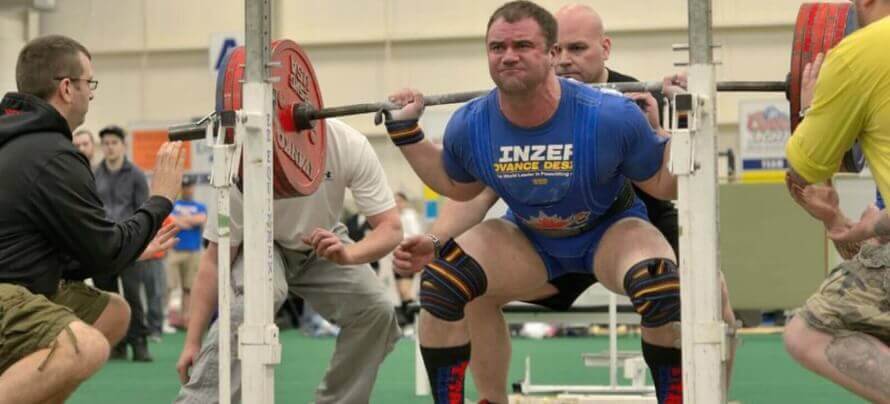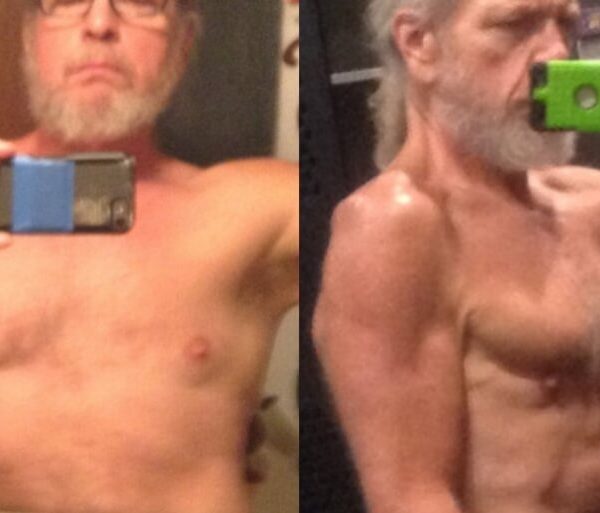What’s the Best Time of Day to Lift Weights? What 35 Studies Say
Key Takeaways
- Although most people are slightly stronger in the evening than in the morning, the differences are small and mostly disappear after several weeks of morning workouts.
- Research shows that you should probably train at whatever time you prefer—if you’re a morning person, train in the morning; if you’re an evening person, train in the evening.
- If you currently lift weights in the evening and would like to start lifting weights in the morning, keep reading to learn seven strategies for making your morning workouts more productive.
What’s the best time of day to lift weights?
Search for an answer to that question online and you’ll learn that there are basically two schools of thought on this issue:
- It’s best to train in the late afternoon or evening.
- It doesn’t much matter when you train.
Proponents of the first position point to studies that show athletes perform better later in the day and claim that if you do the same, you’ll be able to use heavier weights in your workouts and gain more muscle and strength as a result.
Advocates of the second position claim that although most people have better workouts in the evening, your body can also adjust to morning workouts over time, nullifying any benefits of training in the evening.
Who’s right?
Is training in the latter half of the day really superior to training in the first half? And if so, is the difference enough to matter?
Or, can you get equally good results regardless of what time you train?
Keep reading to learn what science says.
Workout Times and Circadian Rhythms
Before you can determine what the “best” time of day is to work out, you first have to understand the concept of circadian rhythms.
Your circadian rhythm, often referred to as your “biological clock,” is a collection of physiological processes that repeat roughly every 24 hours and regulate myriad different functions in the body including sleep, eating habits, hunger, digestion, bowel movements, body temperature, and hormone levels.
One of the most obvious examples of a bodily process that follows a circadian rhythm is your sleep-wake cycle. If you’re like most people, you wake up sometime between 6 and 8 a.m., stay awake for around 16 hours, and then go to bed sometime between 10 p.m. and midnight.
A more accurate term for these processes would be circadian rhythms, since your body has many different internal “schedules” running at different times.
As you can imagine, many of these processes also have a significant impact on your athletic performance.
The circadian rhythms that have the biggest impact on your workouts are:
- The sleep-wake cycle
- The body-temperature cycle
- The testosterone cycle
Let’s take a look at each of these in more detail.
The Sleep-Wake Cycle
One of the countless ways we humans differ from one another is our individual preference for what time we like to go to sleep and wake up, also known as our chronotype.
There are “early birds” who like to wake up and go to bed early, and “night owls” who like to stay up and wake up late, although the vast majority of us fall somewhere between these two extremes.
While it’s possible to change your chronotype over time (learning to wake up early despite being a night owl and vice versa), studies show that matching your chronotype to your daily exercise routine can improve your performance.
For example, research shows that elite athletes tend to pursue and excel in sports that match their chronotype.
People who are night owls may be more inclined to take part in track and field events, swimming, and gymnastics—sports where competitions typically occur in the afternoon and evening. People who are early birds may be more inclined to pursue triathlon, long-distance running, and other sports where competitions typically occur in the morning.
More evidence of the benefits of matching your chronotype to workouts comes from a study conducted by scientists at the Martha Jefferson Hospital Sleep Medicine Center. The researchers found that baseball players who were early birds had higher batting averages than night owls in early games (before 2 p.m.), while night owls had higher batting averages than early birds during evening games (after 8 p.m.).
Summary: If you’re a morning person, you’ll likely perform better when exercising in the morning or early afternoon. If you’re an evening person, you’ll likely perform better when exercising in the late afternoon or evening.
The Body-Temperature Cycle
Core body temperature is the temperature of your internal organs (usually your liver).
Many biological systems are sensitive to variations in your core temperature, so your body goes to great lengths to keep it in a narrow range of 97.7 to 101.3 °F (36.5 to 38.5 ℃).
Most of the systems involved in exercise—your musculoskeletal, cardiovascular, and nervous systems—function optimally when your core temperature is a little higher than normal. This is because a higher core temperature improves:
For most people, core temperature is lowest at night, rises upon waking, and reaches its peak in the evening. In theory, this means training later in the day should lead to more productive workouts and thus better strength and muscle gain.
This may partly explain why research shows people tend to perform better later in the day, and why sporting records tend to be broken in the late afternoon and early evening.
That said, even if training in the evening does slightly improve your performance, this doesn’t necessarily mean this translates into more strength and muscle gain (keep reading to learn why).
Summary: Your body temperature tends to be higher in the evening than in the morning, and this may improve athletic performance.
The Testosterone Cycle
If you ask the average gym-goer what’s the biggest hormonal driver of muscle growth, they would probably answer “testosterone.”
And it would be hard to argue.
Testosterone is the primary “anabolic” hormone (meaning it builds substances up, including muscle) in the human body.
You may have heard that testosterone peaks in the morning and drops at the end of the day, and worry that training in a lower-T environment could decrease how much muscle and strength you gain.
While it’s true that testosterone reaches its lowest point in the evening, research shows that strength training in the evening actually produces a larger increase in testosterone levels than strength training in the morning.
This fact becomes even more important when you consider the daily rhythms of another important hormone: cortisol.
Cortisol is a “catabolic” hormone, which means it breaks substances down, including muscle and fat. Like testosterone, resting cortisol levels are highest in the morning, before waking, and progressively decline as the day goes on, reaching a low point in the evening.
Also like testosterone, cortisol levels spike during and immediately after lifting weights. When you train in the evening, though, this spike in cortisol tends to be lower and disappears faster than if you train in the morning.
Since maintaining a high ratio of testosterone to cortisol is preferable if you want to maximize muscle growth, many researchers have theorized that training in the afternoon or evening, (when the ratio of testosterone to cortisol is at its best) might provide a more anabolic environment for gaining muscle and strength.
As you’ll learn in a moment, though, this theory hasn’t panned out in practice.
Summary: Testosterone and cortisol levels are (hypothetically) more conducive to muscle growth in the evening, although this remains to be proven.
How Your Workout Timing Affects Strength and Muscle Gain

On the whole, most studies show that you’ll gain muscle and strength slightly faster if you train in the afternoon or evening than if you train in the morning.
For example, research conducted by scientists at The College of William and Mary looked at how training at different times of day affected the athletic performance of ten healthy, untrained men. The researchers had the men do a workout that involved 3 sets of 5 reps and a 1 set of 50 reps on an isometric leg extension and curl machine.
Each person repeated the workout a total of four times—at 8 a.m., 12 p.m., 4 p.m., and 8 p.m.—and they were able to produce slightly more force with their leg muscles at 4 p.m. and 8 p.m. than they were at 8 a.m. and 12 p.m.
Two other studies—one conducted by scientists at the University of Bourgogne and the other at the University of Jyväskylä—also found that the subject’s quadriceps muscles were stronger in the evening than in the morning.
Other research has found much the same thing when it comes to muscle growth.
For example, a study conducted by scientists at the University of Jyväskylä split 52 untrained men between the ages of 26 and 37 years old into two groups:
- A group that lifted weights in the morning.
- A group that lifted weights in the evening.
All of the participants trained twice per week for 12 weeks and about 3 times per week for the final 12 weeks of the study, for a total of 24 weeks of training. The weightlifting program involved a combination of circuit training, moderate-weight, high-rep hypertrophy training, and heavy-weight, low-rep strength training, and the workouts involved a variety of upper- and lower-body exercises.
Read: The 12 Best Science-Based Strength Training Programs for Gaining Muscle and Strength
The researchers measured the participants’ leg press one-rep max, peak isometric strength on a leg extension machine, and used ultrasound scans to measure their quadriceps muscle size.
The result?
Both groups improved their strength equally, but the group that lifted weights in the evening gained slightly more muscle mass than the group that lifted weights in the morning. The researchers also found that the difference in muscle growth between the two groups only became apparent halfway through the study, indicating it may take up to three months or more for any benefits of evening training to become apparent.
This jives with a previous study conducted by scientists at the University of Jyväskylä, which had subjects follow a 10-week strength training program, with one group training in the morning (between 7 a.m. and 9 a.m.) and the other training in the afternoon (between 5 p.m. and 7 p.m.).
At the end of the study, the researchers found that people training in the morning increased their quad muscle mass by about 2.7% and those training in the afternoon by 3.5%. This measly 0.8% difference wasn’t statistically significant, but it may just take more than a few weeks for the benefits of training in the evening to accrue.
Another unpublished study from the same university found more significant results. In this case, they found that men who trained in the evening increased their quad muscle mass by 3.21% after 10 weeks, while men who trained in the morning only increased it by 0.64%.
At this point you’re probably thinking, training in the evening is clearly superior to training in the morning, right?
And, as a corollary, training in the morning must put you at a disadvantage when it comes to gaining muscle and strength, yes?
Not exactly.
As you now know, most studies show that people are usually weaker in the morning than in the evening. That said, new research shows that if you consistently train in the morning, this handicap disappears over time. Specifically, if you switch from training in the evening to training in the morning, you can expect your strength to dip about 5 to 10% at first, but it should return to normal after about a month or so.
What’s more, your personal preferences play a major role in determining your workout performance. If you prefer working out in the morning to working out in the evening, that may be the better choice, even if Science™ says it isn’t “optimal.”
At least, that’s what a recent study conducted by scientists at Samford University suggests.
In this study, researchers asked 12 college-aged men with an average of 6 years of weightlifting experience each to come to the lab on 3 separate occasions.
On the first visit, the researchers had the men perform a bench press one-rep max test and answer two questions to determine their preferred training time:
- “If you were entirely free to plan your day with no other time commitments, what time of day would you prefer to exercise?”
- “What time of day would you choose to exercise if you wanted to perform your best?”
For both questions, the only answers the participants could give were “a.m. or “p.m.,” and to be included in the following stages of the study, participants had to give the same answer to both questions.
On the second and third visits, the participants did a weightlifting workout in the morning at 8 a.m. on one visit and in the afternoon at 4 p.m. on the other visit.
The first thing the researchers did in both sessions assessed the participants’ motivation to train using a visual analogue scale (the participants indicated how motivated they felt to train on a scale from 0 to 100).
After that, the participants performed two sets of two reps on the bench press at 75% of their one-rep max with 5 minutes of rest between sets. Although both sets were recorded, only the set with the fastest velocity was included in the results. (A faster weightlifting velocity is a sign that the participants felt less fatigued and more vigorous).
Finally, the participants took one more 5-minute rest, before performing a set of bench press to failure with 75% of their one-rep max. Once that set was complete, the researchers assessed how hard the participants felt the session had been using an RPE scale.
The researchers found that the participants performed the same number of reps on their last set regardless of what time of day they trained, but the speed at which they lifted was slightly faster in the afternoon.
More importantly, however, they found that when the participants trained at their preferred time of day they were more motivated to work out and felt the workouts were easier. This was particularly evident in people who preferred to train in the evening, but who had to train in the morning for the study. (That is, night owls had a harder time adapting to morning workouts than early birds did adapting to evening workouts).
The key takeaway from this study is that although there might be some small benefit to training in the evening, it’s minor, and probably less important than training at your preferred time of day.
And what of those claims that training in the evening optimizes your hormones for building muscle?
Well, research shows that’s mostly a bunch of bull dust.
Although training when the ratio of testosterone to cortisol is at its highest sounds beneficial, several pieces of research suggest it has little to no effect on strength or muscle growth.
For example, one study conducted by researchers at the University of the West of Scotland had 17 untrained male students report to the lab at 9 a.m. and 5 p.m., and perform a 5-meter sprint test and a squat one-rep max test on each visit.
To assess their levels of testosterone and cortisol, participants gave three separate saliva samples: one immediately prior to testing, another 5 minutes after testing, and one more an hour after testing.
The results showed that there was no correlation between sprint performance, squat one-rep max strength, and testosterone or cortisol levels. (As with most other studies on this topic, though, the researchers did find that both sprint and squat performance were slightly better in the evening).
So where does that leave us?
All else being equal, you’ll probably gain muscle and strength slightly faster if you lift weights in the afternoon or evening.
That said, if you prefer lifting weights in the morning or that suits your schedule better, your body will adjust after a month or so, and you probably won’t be at much of any disadvantage.
Remember that the most important factor in gaining muscle and strength is consistency, and if training in the morning helps you stick to your workout, then that will give you better results.
Think of it this way:
- If you had to choose between training in the evening, knowing that you’d probably miss one or two workouts per month due to scheduling conflicts; or training in the morning and knowing that you’d complete every workout, you’d be better off training in the morning.
- If you prefer training in the morning to training in the evening, then you’ll probably get better results training in the morning regardless of what most studies show.
- If you don’t have a strong preference for morning or evening training, and you know you can consistently train in the evening, then that would be a slightly better choice than training in the morning.
Summary: Most people are able to lift slightly more weight in the evening than in the morning, though the difference is relatively small and tends to disappear over time (your body adapts to morning workouts).
How to Make Morning Training Work for You

If you currently train in the morning and you want to train in the evening, you don’t need to worry about any special strategies to make the transition work—just start showing up at the gym in the evening.
That said, if you currently take a pre-workout supplement before training, you may want to switch to a caffeine-free pre-workout if you start training in the evening.
If you currently train in the evening and want to start training in the morning, though, there are a few techniques that will make the switch less bothersome.
Here are seven strategies to help you adapt to morning workouts:
1. Go to bed earlier and wake up earlier.
If you want to start waking up earlier, you first have to start going to bed earlier to ensure you get sufficient sleep every night (7 to 9 hours for most people).
Aside from simply going to bed earlier, it’s also wise to create a pre-bed routine to help you fall asleep faster and stay asleep through the night. Taking a sleep aid supplement that contains melatonin, like Lunar, can help too, especially during the first few weeks as your body adjusts to your new sleep schedule.
Finally, make sure you stick to your new sleep-wake schedule every day. Sleeping in on weekends or days you don’t train will interfere with your new sleep schedule and make it harder to wake up on the days you want to train in the morning.
2. Try to wake up at least an hour before you lift weights.
Rolling out of bed like a log off a truck and dragging yourself straight to the gym is probably going to reduce your workout performance, even if you can (somewhat) get used to it.
Although it may seem counterintuitive, getting up slightly earlier to allow yourself time to shake off the cobwebs can help you have more productive workouts. Plus, it provides time for the caffeine from your coffee or pre-workout supplement to kick in. Speaking of pre-workouts . . .
3. Take a pre-workout supplement or drink coffee upon waking.
Research shows that caffeine improves strength, muscle endurance, and anaerobic performance. Most importantly, though, it’s been shown to reverse the “morning weakness” experienced by many people who start lifting weights in the early hours.
If you’re not a fan of coffee, have a serving of a pre-workout that contains caffeine, like Pulse—it’ll increase your energy levels, improve your mood, and sharpen your mental focus.
4. Eat some protein and/or carbs 30 to 60 minutes before training.
Eating around 30 grams of both protein and carbs prior to training will help you perform better and recover faster than if you hit the gym on an empty stomach.
If you prefer to train fasted, taking some HMB or around 10 grams of whey protein mixed with water 15 to 30 minutes before your workout will help to negate any potential muscle loss caused by fasted training.
5. Do a thorough warm-up.
As we’ve already discussed, one of the reasons people tend to perform better in the afternoon or evening is their core body temperature is higher than it is in the morning.
You can quickly raise your core body temperature, though, by doing a thorough warm-up before your morning workouts. A simple way to do this is to do 5 to 10 minutes of cardio before you start lifting weights—just enough to break a sweat, but not enough to fatigue you.
Create a morning routine that you look forward to.
If getting up early feels like self-flagellation, creating a morning ritual that you look forward to can help take the edge off.
Here are a few ideas:
7. Consider doing one-rep max tests in the afternoon or evening.
Even if you do the majority of your training in the morning, you’ll still probably be a bit stronger in the afternoon or evening. Thus, if you want to lift as much weight as possible, as when you’re doing a one-rep max or rep-max test, it’s best to lift in the afternoon or evening.
The Bottom Line on the Best Time of Day to Lift Weights
Remember that consistency is the keystone of building a great physique—the “optimal” time to lift weights is whenever you can reliably do so, whether that’s the evening, mid-afternoon, or early morning.
If you don’t much care when you train or you can reliably go in the morning or evening, though, you may be able to lift a little more weight or squeeze out an extra rep or two if you train in the evening.
If you currently train in the evening and would like to start training in the morning, your strength will probably skid a little at first, but it should rebound after your body adapts to your new schedule.
If you’d like to switch from training in the evening to morning, here are seven strategies to help:
- Go to bed earlier and wake up earlier.
- Try to wake up at least an hour before you lift weights.
- Take a pre-workout supplement or drink coffee upon waking (I recommend Pulse)
- Eat some protein and/or carbs 30 to 60 minutes before training.
- Do a thorough warm-up.
- Create a morning routine that you look forward to.
- Consider doing one-rep max tests in the afternoon or evening.
If you liked this article, please share it on Facebook, Twitter, or wherever you like to hang out online! 🙂
What’s your take on the best time of day to lift weights? Have anything else to share? Let me know in the comments below!
+ Scientific References
- Mora-Rodríguez, R., Pallarés, J. G., López-Samanes, Á., Ortega, J. F., & Fernández-Elías, V. E. (2012). Caffeine ingestion reverses the circadian rhythm effects on neuromuscular performance in highly resistance-trained men. PLoS ONE, 7(4). https://doi.org/10.1371/journal.pone.0033807
- Beck, T. W., Housh, T. J., Schmidt, R. J., Johnson, G. O., Housh, D. J., Coburn, J. W., & Malek, M. H. (2006). The acute effects of a caffeine-containing supplement on strength, muscular endurance, and anaerobic capabilities. Journal of Strength and Conditioning Research, 20(3), 506–510. https://doi.org/10.1519/18285.1
- Astorino, T. A., Rohmann, R. L., & Firth, K. (2008). Effect of caffeine ingestion on one-repetition maximum muscular strength. European Journal of Applied Physiology, 102(2), 127–132. https://doi.org/10.1007/s00421-007-0557-x
- Hayes, L., Grace, F. M., LonKilgore, J., Young, J. D., & Baker, J. S. (n.d.). SALIVARY HORMONE RESPONSE TO MAXIMAL EXERCISE AT TWO TIME POINTS DURING THE DAY. Retrieved December 1, 2020, from https://www.academia.edu/6268365/SALIVARY_HORMONE_RESPONSE_TO_MAXIMAL_EXERCISE_AT_TWO_TIME_POINTS_DURING_THE_DAY
- Souissi, N., Gauthier, A., Sesboüé, B., Larue, J., & Davenne, D. (2002). Effects of regular training at the same time of day on diurnal fluctuations in muscular performance. Journal of Sports Sciences, 20(11), 929–937. https://doi.org/10.1080/026404102320761813
- West, D. W. D., Burd, N. A., Tang, J. E., Moore, D. R., Staples, A. W., Holwerda, A. M., Baker, S. K., & Phillips, S. M. (2010). Elevations in ostensibly anabolic hormones with resistance exercise enhance neither training-induced muscle hypertrophy nor strength of the elbow flexors. Journal of Applied Physiology, 108(1), 60–67. https://doi.org/10.1152/japplphysiol.01147.2009
- Blazer, H. J., Jordan, C. L., Pederson, J. A., Rogers, R. R., Williams, T. D., Marshall, M. R., & Ballmann, C. G. (2020). Effects of Time-of-Day Training Preference on Resistance-Exercise Performance. Research Quarterly for Exercise and Sport, 1–8. https://doi.org/10.1080/02701367.2020.1751032
- Jančoková, Ľ., Alabed, H., Waterhouse, J., & Homolka, P. (n.d.). (PDF) Chronobiology from theory to sports practice. Retrieved December 1, 2020, from https://www.researchgate.net/publication/299979206_Chronobiology_from_theory_to_sports_practice
- Sedliak, M., Zeman, M., Buzgó, G., Cvecka, J., Hamar, D., Laczo, E., Okuliarova, M., Vanderka, M., Kampmiller, T., Häkkinen, K., Ahtiainen, J. P., Hulmi, J. J., Nilsen, T. S., Wiig, H., & Raastad, T. (2018). Morphological, molecular and hormonal adaptations to early morning versus afternoon resistance training. Chronobiology International, 35(4), 450–464. https://doi.org/10.1080/07420528.2017.1411360
- Küüsmaa, M., Schumann, M., Sedliak, M., Kraemer, W. J., Newton, R. U., Malinen, J. P., Nyman, K., Häkkinen, A., & Häkkinen, K. (2016). Effects of morning versus evening combined strength and endurance training on physical performance, muscle hypertrophy, and serum hormone concentrations. Applied Physiology, Nutrition and Metabolism, 41(12), 1285–1294. https://doi.org/10.1139/apnm-2016-0271
- Küüsmaa-Schildt, M., Eklund, D., Avela, J., Rytkönen, T., Newton, R., Izquierdo, M., & Häkkinen, K. (2017). Neuromuscular Adaptations to Combined Strength and Endurance Training: Order and Time-of-Day. International Journal of Sports Medicine, 38(9), 707–716. https://doi.org/10.1055/s-0043-101376
- Sedliak, M., Finni, T., Peltonen, J., & Hakkinen, K. (2008). Effect of time-of-day-specific strength training on maximum strength and EMG activity of the leg extensors in men. Journal of Sports Sciences, 26(10), 1005–1014. https://doi.org/10.1080/02640410801930150
- Guette, M., Gondin, J., & Martin, A. (2005). Time-of-day effect on the torque and neuromuscular properties of dominant and non-dominant quadriceps femoris. Chronobiology International, 22(3), 541–558. https://doi.org/10.1081/CBI-200062407
- Deschenes, M. R., Kraemer, W. J., Bush, J. A., Doughty, T. A., Kim, D., Mullen, K. M., & Ramsey, K. (1998). Biorhythmic influences on functional capacity of human muscle and physiological responses. Medicine and Science in Sports and Exercise, 30(9), 1399–1407. https://doi.org/10.1097/00005768-199809000-00008
- Bird, S. P., & Tarpenning, K. M. (2004). Influence of Circadian Time Structure on Acute Hormonal Responses to a Single Bout of Heavy-Resistance Exercise in Weight-Trained Men. Chronobiology International, 21(1), 131–146. https://doi.org/10.1081/CBI-120027987
- Ibrahim Erdemir, Ali kizilet, & Tuba Kizilet Bozdogan. (n.d.). Effects of Exercise on Circadian Rhythms of Cortisol. Retrieved December 1, 2020, from http://article.sapub.org/10.5923.j.sports.20130303.02.html
- Kanaley, J. A., Weltman, J. Y., Pieper, K. S., Weltman, A., & Hartman, M. L. (2001). Cortisol and Growth Hormone Responses to Exercise at Different Times of Day 1 . The Journal of Clinical Endocrinology & Metabolism, 86(6), 2881–2889. https://doi.org/10.1210/jcem.86.6.7566
- Deschenes, M. R., Bronson, L. L., Cadorette, M. P., Powers, J. E., & Weinlein, J. C. (2002). Aged men display blunted biorhythmic variation of muscle performance and physiological responses. Journal of Applied Physiology, 92(6), 2319–2325. https://doi.org/10.1152/japplphysiol.01116.2001
- Atkinson, G., & Reilly, T. (1996). Circadian variation in sports performance. In Sports Medicine (Vol. 21, Issue 4, pp. 292–312). Springer International Publishing. https://doi.org/10.2165/00007256-199621040-00005
- Atkinson, G., Coldwells, A., Reilly, T., & Waterhouse, J. (1993). A comparison of circadian rhythms in work performance between physically active and inactive subjects. Ergonomics, 36(1–3), 273–281. https://doi.org/10.1080/00140139308967882
- Gauthier, A., Davenne, D., Martin, A., Cometti, G., & Van Hoecke, J. (1996). Diurnal rhythm of the muscular performance of elbow flexors during isometric contractions. Chronobiology International, 13(2), 135–146. https://doi.org/10.3109/07420529609037077
- Wyse, J. P., Mercer, T. H., & Gleeson, N. P. (1994). Time-of-day dependence of isokinetic leg strength and associated interday variability. British Journal of Sports Medicine, 28(3), 167–170. https://doi.org/10.1136/bjsm.28.3.167
- Souissi, N., Gauthier, A., Sesboüé, B., Larue, J., & Davenne, D. (2002). Effects of regular training at the same time of day on diurnal fluctuations in muscular performance. Journal of Sports Sciences, 20(11), 929–937. https://doi.org/10.1080/026404102320761813
- Chtourou, H., Driss, T., Souissi, S., Gam, A., Chaouachi, A., & Souissi, N. (2012). The Effect of Strength Training at the Same Time of the Day on the Diurnal Fluctuations of Muscular Anaerobic Performances. Journal of Strength and Conditioning Research, 26(1), 217–225. https://doi.org/10.1519/JSC.0b013e31821d5e8d
- Sedliak, M., Finni, T., Peltonen, J., & Hakkinen, K. (2008). Effect of time-of-day-specific strength training on maximum strength and EMG activity of the leg extensors in men. Journal of Sports Sciences, 26(10), 1005–1014. https://doi.org/10.1080/02640410801930150
- Guette, M., Gondin, J., & Martin, A. (2005). Time-of-day effect on the torque and neuromuscular properties of dominant and non-dominant quadriceps femoris. Chronobiology International, 22(3), 541–558. https://doi.org/10.1081/CBI-200062407
- Reilly, T., & Waterhouse, J. (2009). Sports performance: Is there evidence that the body clock plays a role? In European Journal of Applied Physiology (Vol. 106, Issue 3, pp. 321–332). Eur J Appl Physiol. https://doi.org/10.1007/s00421-009-1066-x
- Karvonen, M. J. (1977). ENDURANCE SPORTS, LONGEVITY, AND HEALTH. Annals of the New York Academy of Sciences, 301(1), 653–655. https://doi.org/10.1111/j.1749-6632.1977.tb38236.x
- Mawhinney, C., & Allan, R. (2018). Muscle cooling: too much of a good thing? In Journal of Physiology (Vol. 596, Issue 5, pp. 765–767). Blackwell Publishing Ltd. https://doi.org/10.1113/JP275695
- V F Ferrario, G Tredici, & V Crespi. (n.d.). Circadian rhythm in human nerve conduction velocity – PubMed. Retrieved December 1, 2020, from https://pubmed.ncbi.nlm.nih.gov/7428511/
- Thorne, A. M., Ubbink, R., Bruggenwirth, I. M. A., Nijsten, M. W., Porte, R. J., & de Meijer, V. E. (2020). Hyperthermia-induced changes in liver physiology and metabolism: A rationale for hyperthermic machine perfusion. In American Journal of Physiology – Gastrointestinal and Liver Physiology (Vol. 319, Issue 1, pp. G43–G50). American Physiological Society. https://doi.org/10.1152/ajpgi.00101.2020
- Lastella, M., Roach, G. D., Halson, S. L., & Sargent, C. (2016). The chronotype of elite athletes. Journal of Human Kinetics, 54(1), 219–225. https://doi.org/10.1515/hukin-2016-0049
- Drust, B., Waterhouse, J., Atkinson, G., Edwards, B., & Reilly, T. (2005). Circadian rhythms in sports performance – An update. In Chronobiology International (Vol. 22, Issue 1, pp. 21–44). Taylor and Francis Inc. https://doi.org/10.1081/CBI-200041039
- Lastella, M., Roach, G. D., Hurem, D. C., & Sargent, C. (n.d.). (PDF) Does chronotype affect elite athletes’ capacity to cope with the training demands of elite triathlon? Retrieved December 1, 2020, from https://www.researchgate.net/publication/258890038_Does_chronotype_affect_elite_athletes’_capacity_to_cope_with_the_training_demands_of_elite_triathlon
- Facer-Childs, E. R., Middleton, B., Skene, D. J., & Bagshaw, A. P. (2019). Resetting the late timing of ‘night owls’ has a positive impact on mental health and performance. Sleep Medicine, 60, 236–247. https://doi.org/10.1016/j.sleep.2019.05.001
If you enjoyed this article, get weekly updates. It’s free.
Sending…
Great! You’re subscribed.
100% Privacy. We don’t rent or share our email lists.








